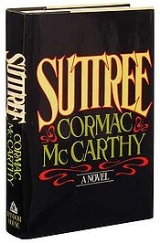
Suttree
Encyclopedia
Suttree is a semi-autobiographical novel by Cormac McCarthy
, published in 1979. Set in 1951 in Knoxville, Tennessee
, the novel follows Cornelius Suttree, who has repudiated his former life of privilege to become a fisherman on the Tennessee River
. The novel has a fragmented structure with many flashbacks and shifts in grammatical person
. Suttree has been compared to James Joyce
's Ulysses
, John Steinbeck
's Cannery Row
, and called "a doomed version" of Mark Twain
's Adventures of Huckleberry Finn
. Suttree was written over a 30-year span and is a departure from his previous novels, being much longer, more sprawling in structure, and perhaps McCarthy's most humorous novel.
. He has left a life of luxury, rejecting his father and family, and abandoning his wife and son.
 A large cast of characters, largely misfits and grotesque
A large cast of characters, largely misfits and grotesque
s, is introduced, one of which is Gene Harrogate, whom Suttree meets in a work camp. Harrogate was sent to the work camp for having sex with a farmer's watermelons. Suttree attempts to take Harrogate under his wing once out of the work camp, but this task proves to be in vain as Harrogate sets off on a series of misadventures, such as using poisoned meat and a slingshot to kill bats ("flitter-mice" as Harrogate calls them) to earn a bounty
on them, and using dynamite to attempt to tunnel underneath the city. Other prominent characters are prostitutes, hermits, and an aged Geechee witch.
His relationships with women all come to bad ends. One prostitute-girlfriend terminates the relationship in a moment of madness, smashing up the inside of their new car. The other woman with whom he becomes involved is killed by a landslide on the river bank. Suttree is also married before the book begins with a woman he apparently met during college. He left his wife with a son, who dies early on in the book.
Towards the novel's end, Suttree falls ill with typhoid fever
and suffers a lengthy hallucination
. This occurs after a black friend of Suttree's is killed in a fight with the police and his other friend Harrogate is arrested for robbing a store, so Suttree decides to leave town. In the end, he feels his identity is reaffirmed, and he leaves Knoxville, possibly for good.
argued that the novel was “a memorable American comedy by an original storyteller.” Estimable reviews by such noted writers and literary critics as Anatole Broyard
, Jerome Charyn
, Guy Davenport
, and Shelby Foote
were followed by the Times Literary Supplement review which saw the novel as “Faulknerian in its gentle wryness, and a freakish imaginative flair reminiscent of Flannery O'Connor.” The influential profile writer and music journalist Stanley Booth
observed that Suttree was “probably the funniest and most unbearably sad of McCarthy’s books...which seem to me unsurpassed in American literature.” On the anecdotal level, film critic Roger Ebert
wrote that he had read all of McCarthy's novels, and considered Suttree to be McCarthy's masterpiece.
Cormac McCarthy
Cormac McCarthy is an American novelist and playwright. He has written ten novels, spanning the Southern Gothic, Western, and modernist genres. He received the Pulitzer Prize and the James Tait Black Memorial Prize for Fiction for The Road...
, published in 1979. Set in 1951 in Knoxville, Tennessee
Knoxville, Tennessee
Founded in 1786, Knoxville is the third-largest city in the U.S. state of Tennessee, U.S.A., behind Memphis and Nashville, and is the county seat of Knox County. It is the largest city in East Tennessee, and the second-largest city in the Appalachia region...
, the novel follows Cornelius Suttree, who has repudiated his former life of privilege to become a fisherman on the Tennessee River
Tennessee River
The Tennessee River is the largest tributary of the Ohio River. It is approximately 652 miles long and is located in the southeastern United States in the Tennessee Valley. The river was once popularly known as the Cherokee River, among other names...
. The novel has a fragmented structure with many flashbacks and shifts in grammatical person
Grammatical person
Grammatical person, in linguistics, is deictic reference to a participant in an event; such as the speaker, the addressee, or others. Grammatical person typically defines a language's set of personal pronouns...
. Suttree has been compared to James Joyce
James Joyce
James Augustine Aloysius Joyce was an Irish novelist and poet, considered to be one of the most influential writers in the modernist avant-garde of the early 20th century...
's Ulysses
Ulysses (novel)
Ulysses is a novel by the Irish author James Joyce. It was first serialised in parts in the American journal The Little Review from March 1918 to December 1920, and then published in its entirety by Sylvia Beach on 2 February 1922, in Paris. One of the most important works of Modernist literature,...
, John Steinbeck
John Steinbeck
John Ernst Steinbeck, Jr. was an American writer. He is widely known for the Pulitzer Prize-winning novel The Grapes of Wrath and East of Eden and the novella Of Mice and Men...
's Cannery Row
Cannery Row (novel)
Cannery Row is an English language novel by American author John Steinbeck. It was published in 1945. A film version was released in 1982. A stage version was produced in 1995....
, and called "a doomed version" of Mark Twain
Mark Twain
Samuel Langhorne Clemens , better known by his pen name Mark Twain, was an American author and humorist...
's Adventures of Huckleberry Finn
Adventures of Huckleberry Finn
Adventures of Huckleberry Finn is a novel by Mark Twain, first published in England in December 1884 and in the United States in February 1885. Commonly named among the Great American Novels, the work is among the first in major American literature to be written in the vernacular, characterized by...
. Suttree was written over a 30-year span and is a departure from his previous novels, being much longer, more sprawling in structure, and perhaps McCarthy's most humorous novel.
Plot summary
The novel begins with Suttree observing police as they pull a suicide from the river. Suttree is living alone in a houseboat, on the fringes of society on the Tennessee River, earning money by fishing for the occasional catfishCatfish
Catfishes are a diverse group of ray-finned fish. Named for their prominent barbels, which resemble a cat's whiskers, catfish range in size and behavior from the heaviest and longest, the Mekong giant catfish from Southeast Asia and the second longest, the wels catfish of Eurasia, to detritivores...
. He has left a life of luxury, rejecting his father and family, and abandoning his wife and son.

Grotesque
The word grotesque comes from the same Latin root as "Grotto", meaning a small cave or hollow. The original meaning was restricted to an extravagant style of Ancient Roman decorative art rediscovered and then copied in Rome at the end of the 15th century...
s, is introduced, one of which is Gene Harrogate, whom Suttree meets in a work camp. Harrogate was sent to the work camp for having sex with a farmer's watermelons. Suttree attempts to take Harrogate under his wing once out of the work camp, but this task proves to be in vain as Harrogate sets off on a series of misadventures, such as using poisoned meat and a slingshot to kill bats ("flitter-mice" as Harrogate calls them) to earn a bounty
Bounty (reward)
A bounty is a payment or reward often offered by a group as an incentive for the accomplishment of a task by someone usually not associated with the group. Bounties are most commonly issued for the capture or retrieval of a person or object. They are typically in the form of money...
on them, and using dynamite to attempt to tunnel underneath the city. Other prominent characters are prostitutes, hermits, and an aged Geechee witch.
His relationships with women all come to bad ends. One prostitute-girlfriend terminates the relationship in a moment of madness, smashing up the inside of their new car. The other woman with whom he becomes involved is killed by a landslide on the river bank. Suttree is also married before the book begins with a woman he apparently met during college. He left his wife with a son, who dies early on in the book.
Towards the novel's end, Suttree falls ill with typhoid fever
Typhoid fever
Typhoid fever, also known as Typhoid, is a common worldwide bacterial disease, transmitted by the ingestion of food or water contaminated with the feces of an infected person, which contain the bacterium Salmonella enterica, serovar Typhi...
and suffers a lengthy hallucination
Hallucination
A hallucination, in the broadest sense of the word, is a perception in the absence of a stimulus. In a stricter sense, hallucinations are defined as perceptions in a conscious and awake state in the absence of external stimuli which have qualities of real perception, in that they are vivid,...
. This occurs after a black friend of Suttree's is killed in a fight with the police and his other friend Harrogate is arrested for robbing a store, so Suttree decides to leave town. In the end, he feels his identity is reaffirmed, and he leaves Knoxville, possibly for good.
Reception
Novelist Nelson AlgrenNelson Algren
Nelson Algren was an American writer.-Early life:Algren was born Nelson Ahlgren Abraham in Detroit, Michigan, the son of Goldie and Gerson Abraham. At the age of three he moved with his parents to Chicago, Illinois where they lived in a working-class, immigrant neighborhood on the South Side...
argued that the novel was “a memorable American comedy by an original storyteller.” Estimable reviews by such noted writers and literary critics as Anatole Broyard
Anatole Broyard
Anatole Paul Broyard was an American writer, literary critic and editor for The New York Times. In addition to his many reviews and columns, he published short stories, essays and two books during his lifetime...
, Jerome Charyn
Jerome Charyn
Jerome Charyn is an award-winning American author. With nearly 50 published works, Charyn has earned a long-standing reputation as an inventive and prolific chronicler of real and imagined American life...
, Guy Davenport
Guy Davenport
Guy Mattison Davenport was an American writer, translator, illustrator, painter, intellectual, and teacher.-Life:...
, and Shelby Foote
Shelby Foote
Shelby Dade Foote, Jr. was an American historian and novelist who wrote The Civil War: A Narrative, a massive, three-volume history of the war. With geographic and cultural roots in the Mississippi Delta, Foote's life and writing paralleled the radical shift from the agrarian planter system of the...
were followed by the Times Literary Supplement review which saw the novel as “Faulknerian in its gentle wryness, and a freakish imaginative flair reminiscent of Flannery O'Connor.” The influential profile writer and music journalist Stanley Booth
Stanley Booth
Stanley Booth is an American music journalist. Booth has written extensively about important music figures, including Keith Richards, Otis Redding, Janis Joplin, James Brown, Elvis Presley, Gram Parsons, B.B. King, and Al Green...
observed that Suttree was “probably the funniest and most unbearably sad of McCarthy’s books...which seem to me unsurpassed in American literature.” On the anecdotal level, film critic Roger Ebert
Roger Ebert
Roger Joseph Ebert is an American film critic and screenwriter. He is the first film critic to win a Pulitzer Prize for Criticism.Ebert is known for his film review column and for the television programs Sneak Previews, At the Movies with Gene Siskel and Roger Ebert, and Siskel and Ebert and The...
wrote that he had read all of McCarthy's novels, and considered Suttree to be McCarthy's masterpiece.
External links
- Charyn, J., Suttree, New York Times Book Review, Feb 1979
- William Gillespie, "Sure Do Wish You’d Get Ye One of These Here Taters: An Essay on Cormac McCarthy’s Suttree"
- "Searching for Suttree", by Wes Morgan (2004); photographs of some of the Knoxville locations featured in Suttree

